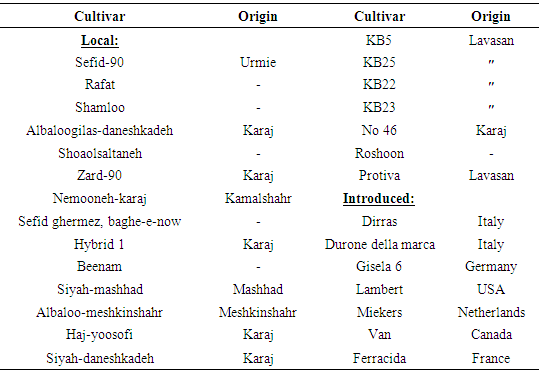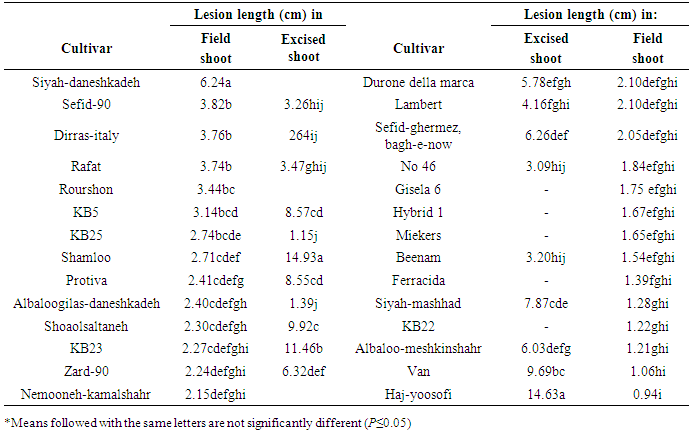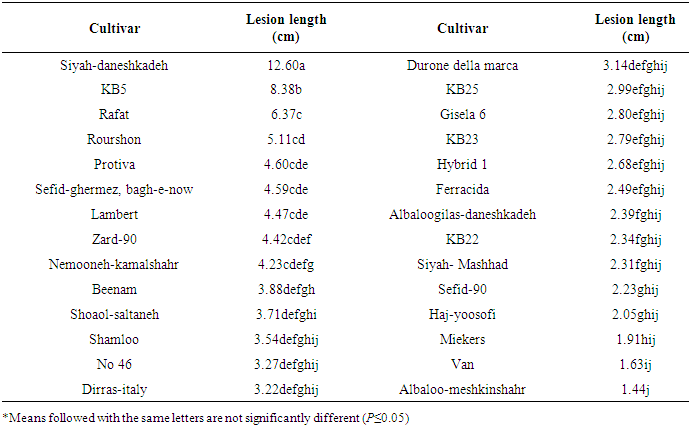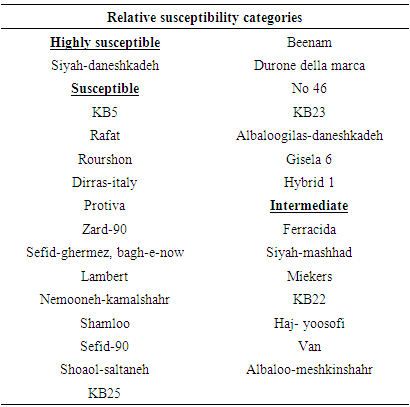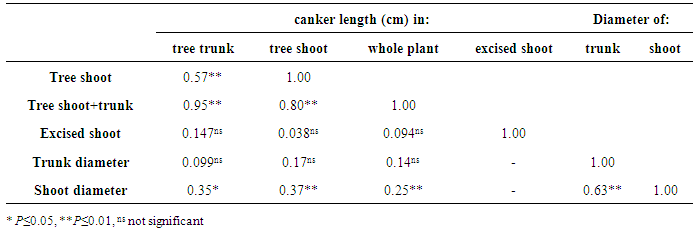| [1] | Agrios, G.N. 2005. Plant Pathology. California: Academic. |
| [2] | Aleta, N., Ninot, A., Moragrega, C., Liorente, I. and Montesinos, E. 2001. Blight sensitivity of Spanish selections of J. regia. Acta Horticulturae. 544. 353-362. |
| [3] | Allen, W.R. and Dirks, V.A. 1978. Bacterial canker of sweet cherry in the Niagara Peninsula of Ontario, Pseudomonas species involved and cultivar susceptibility. Canadian Journal of Plant Sciences. 58. 363-369. |
| [4] | Bahar, M.H., Mojtahedi, S.A. and Akhiani, A. 1985. Bacterial canker of apricot in Isfahan. Iranian Journal of Plant Pathology. 18.58-68. |
| [5] | Banapoor, A., Zakiee, Z. and Amani, G. 1990. Isolation of Pseudomonas syringae pv. syringae on chery trees in Tehran. Iran Journal of Plant Pathology. 26. 67-72. |
| [6] | Bassi, D. 1999. Apricot culture: present and future. Acta Horticulturae. 488. 35-40. |
| [7] | Buzari N, 2006. Evaluation of cherry cultivars for bacterial canker resistance. Proc 17th Plant Protection Congress of Iran, Karaj. 376 (in Persian). |
| [8] | Cameron, H.R. 1971. Effect of root or trunk stock on susceptibility of orchard trees to Pseudomonas syringae. Plant Disease Reporter. 55. 421-423. |
| [9] | Garrett, C.M.E. 1986. Influence of rootstock on the susceptibility of sweet cherry scions to bacterial canker, caused by Pseudomoinas syringae pv. morspronorum and syringae. Plant Pathology. 35. 114-119. |
| [10] | Crosse, J.E., Garrett, C.M.E .1966. Bacterial canker of stone-fruits. VII. Infection experiments with Pseudomonas morsprunorum and P. syringae. Annals of Applied Biology. 58. 31-41. |
| [11] | De Vries, D.P. 1965. Field resistance to bacterial canker in some cherry seedling populations. Euphytica. 14. 78-82. |
| [12] | Elahinia, S.A., Rahimian, H. 1992. Identification angent bactrerial canker os stoem fruit tree in summer area Mazandaran. Proc 11th Plant Protection Congress of Iran. 213 (in Persian). |
| [13] | Fischer, M. and Hohlfed, B. 1998. Resistance tests in sweet cherries. Acta Horticulturae 468: 87-94. |
| [14] | Fuchs, A. and De Vries, D.P. 1964. Optreden,bestrijding en voorkomen van bacteriekanker. Kersen, Meded Dir Tuinb. 27. 546-56. |
| [15] | Fuchs, A.1957. Bakteriekanker bij steenvruchten. 11. De identiteit van Pseudomonas morsprunorum Wormald en Pseudomonas syringae van Hall. Tijdschr PlZiekt 63. 45. |
| [16] | Geibel, M., Gross, D.C., Mo, Y.Y., Bonsal, R.F. and Geiger, H. 1994. Identification of flavonol glycosides from Prunus avium leaves which induce the production of syringomycin by Pseudomonas syringae pv. syringae. Acta Horticulturae. 381. 662-666. |
| [17] | Gerritsen, C.J. and Slits, J.A. 1959. Verslag over het kersenproefveld te Uden. Wageningen IVT, stencil, 11p. |
| [18] | Gilbert, V., Planchon, V., Legras, F, Maraite, H. and Bultreys, A. 2010. Pathogenicity and aggressiveness in populations of P. syringae from Belgian fruit orchards. European Journal of Plant Pathology. 126. 263-277. |
| [19] | Grubb, N.H. 1949. Cherrioes: Crosby lockwood $ Sons Ltd. London: 34-37. |
| [20] | Hamzeneghad, P., Rahimian, H. Ghasemi, A. and Mahmudpur, M. 2004. Investigation of commercial cherry cultivars to bacterial canker and evaluation of polyphenil oxidase and peroxidase as biochemical markers. Proc 16th Plant Protection Congress of Iran. 414 (in Persian). |
| [21] | Janse, J.D. 2006. Phytobacteriology, Principles and Practice. CABI Publishing, Wallinford, UK. |
| [22] | Kaluzna, M., Pulawska, J. and Sobiczewski, P. 2010. The use of PCR melting profile for typing of Pseudomonas syringae isolates from stone fruit trees. European Journal of Plant Pathology. 126. 437-443. |
| [23] | Karimi-Kurdistani, G. and Harighi, B. 2008. Phenotypic and molecular properties of Pseudomonas syringae pv. syringae the causal agent of bacterial canker of stone fruit trees in Kurdistan province. Plant Pathology. 90. 81-86. |
| [24] | Kennelly, M.M., Cazorla, M., de Vincente, A., Ramos, C. and Sundin, G.W. 2007. Pseudomonas syringae diseases of fruit trees, progress toward understanding and control. Plant Disease. 91. 4-17. |
| [25] | Le Lezec, M., Pauline, J.P. and Lecomte, P. 1987. Shoot and blossom susceptibility to fireblight of apple cultivars. Acta Horticulturae. 217. 311-316. |
| [26] | Lelliott, R.A. and Stead, D.E. 1087. Methods for the Diagnosis of Bacterila Disease of Plants. Blackwell Scientific Publications, Oxford, London, UK, pp 169-199. |
| [27] | Lyskanowska, K. and Rejman, A. 1978. Bacterial canker of sweet cherry in Poland. III. Degree of susceptibility of wild cherry seedlings. Plant Disease Reports. 62. 500-503. |
| [28] | Matthews, P. 1959. Bacterial canker of cherries. Ann Rep John Innes Hortic Institution. 50. 14. |
| [29] | Matthews, P. 1979. Progress in breeding cherries for resistance to bacterial canker. Proc Eucarpia Fruit Section Symposium on Tree Fruit Breeding, Angers, pp. 157-174. |
| [30] | Mo, Y.Y., Geibel, M.. Bonsal, R.F. and Gross, D.C. 1995. Analysis of sweet cherry leaves for plant signal molecules that activate the syrB gene required for synthesis of the phytotoxin syringomycin, by Pseudomonas syringae pv. syringae. Plant Physiology. 107. 603-612. |
| [31] | Muranty, H., Schermann, N., Santi, F. and Dufour, J. 1998: Genetic parameters estimated from a wild cherry diallel: consequences for breeding. Silvae Genetics. 47. 249-257. |
| [32] | Nicoll, F.J. 1993. Genetic improvement of cherry for farm woodlands. Quaternar Journal of Forestry. 8. 187-194. |
| [33] | Renick, L.J., Cogal, A.G. and Sundin, G.W. 2008. Phenotypic and genetic analysis of epiphytic Pseudomonas syringae populations from sweet cherry in Michigan. Plant Disease. 92. 372-378. |
| [34] | Roche, M.M. 2001. Development of an in vitro and modification of an in vivo bioassay to screen cherry genotypes for response to inoculation with Pseudomonas syringae pv. syringae. MS thesis, Oregon State University, Corvallis. |
| [35] | Roche, M. and Azarenko, A.N. 2005. An in vitro bioassay to evaluate sweet cherry response to inoculation with Pseudomonas syringae pv. syringae. Acta Horticulturae 667: 503-508. |
| [36] | Santi, F., Russell, K., Me´nard, M. and Dufour, J. 2004. Screening wild cherry (Prunus avium) for resistance to bacterial canker by laboratory and field tests. Forest Pathology. 34. 349-362. |
| [37] | Schaad, N.W., Jones, J.B. and Chun, W. 2001. Laboratory Guide for Identification of Plant Pathogenic Bacteria. APS Press, St. Paul, Minnesota, USA. |
| [38] | Scortichini, M., Biocca, M. and Rossi, M.P. 1995. Pseudomonas syringae pv. morsprunorum on wild cherry for timber production: outbreak and field susceptibility. European Journal of Plant Pathology. 25. 343-350. |
| [39] | Shams-Bakhsh, M. and Rahimian, H. 1989. Characterization of stone fruits bacterial canker in Mazandaran. Proc 9th Plant Protection Congress of Iran. 13 (in Persian). |
| [40] | Spotts, R.A., Facteau, T.J., Cervantes, L.A. and Chestnut, N.E. 1990. Incidence and control of cytospora canker and bacterial canker in young sweet cherry orchard in Oregaon. Plant Disease. 74. 577-580. |
| [41] | Spotts, R.A., Wallis, K.M., Serdani, M. and Azarenko, A.N. 2010. Bacterial canker of sweet cherry in Oregon- Infection of horticultural and natural wounds and resistance of cultivar and rootstock combination. Plant Disease. 94. 345-350. |
| [42] | Thornton, G. and Nugent, J. 2002. Bacterial canker suppression. www.maes.msu.edu/nwmi hort. |
| [43] | Vicente, J.G., Alves, J.P., Russel, K. and Roberts, S.J. 2004. Identification and discrimination of P syringae from wild cherry in englammd. European Journal of Plant Pathology. 110. 337-351. |
| [44] | Vicente, J.G. and Roberts, S.J. 2007. Discrimination pf Pseudomonas isolates from sweet and wild cherry using Rep-PCR. European Journal of Plant Pathology. 117. 383-392. |
| [45] | Webster, A.D. 1980. Dwarfing rootstocks for plums role in cherry canker. Acta Horticulturae. 114. 201-207. |
| [46] | Wilson, E. 1933. Bacterial canker of stone-fruit trees in California. Hilgardia. 8. 83. |
| [47] | Wilson, E. 1953. Bacterial canker of stone fruits. The Yearbook of Agriculture and Plant Diseases. USDA. 722-729. |
| [48] | Young, J.M. 1991. Pathogenicity and identification of the lilac pathogen, Pseudomonas syringae pv. syringae van Hall 1902. Annlals of Applied Biology. 118. 283-298. |
| [49] | Zamze, S. 1983. The structure of lipopolysaccharide from Pseudomonas syringae pv. morsprunorum and its role in canker decay. PhD Thesis, Council for and cherries. National Academic Awards, Thames Polytechnic. |



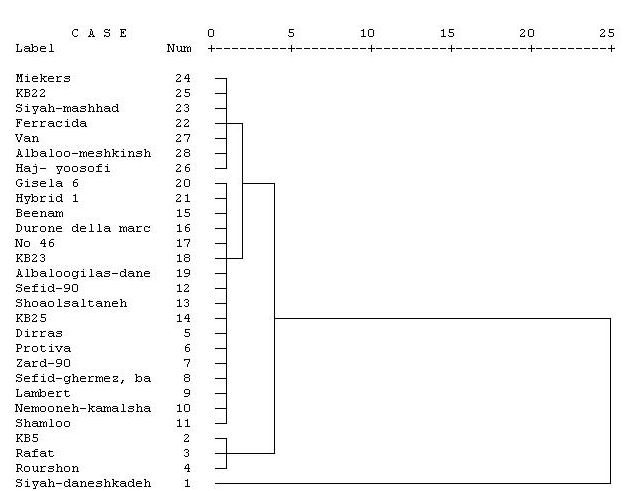
 Abstract
Abstract Reference
Reference Full-Text PDF
Full-Text PDF Full-text HTML
Full-text HTML